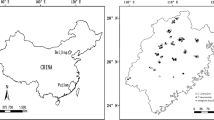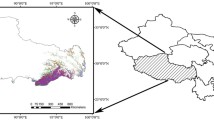Abstract
Using long-term (22 years) measurements from a young and an old-growth subtropical forest in southern China, we found that both forests accumulated carbon from 1982 to 2004, with the mean carbon accumulation rate at 227 ± 59 g C m−2 year−1 for young forest and 115 ± 89 g C m−2 year−1 for the old-growth forest. Allocation of the accumulated carbon was quite different between these two forests: the young forest accumulated a significant amount of carbon in plant live biomass, whereas the old-growth forest accumulated a significant amount of carbon in the soil. From 1982 to 2004, net primary productivity (NPP) increased for the young forest, and did not change significantly for the old-growth forest. The increase in NPP of the young forest resulted from recruitment of some dominant tree species characteristic of the subtropical mature forest in the region and an increase in tree density; decline of NPP of the old-growth forest was caused by increased mortality of the dominant trees.








Similar content being viewed by others
References
Buol SW, Southard RJ, Graham RC, McDaniel PA (2003) Soil genesis and classification, 5th edn. Iowa State Press, Iowa, pp 339–347
Carey EV, Sala A, Keane R, Callaway RM (2001) Are old forest underestimated as global carbon sinks? Glob Change Biol 7:339–344
Clark DA, Brown S, Kicklighter DW, Chambers JQ, Thomalison JR, Ni J, Holland EA (2001) Net primary production in tropical forests: an evaluation and synthesis of existing field data. Ecol Appl 11:371–384
Curtis PS, Hanson PJ, Bolstad P, Barford C, Randolph JC, Schmid HP, Wilson KB (2002) Biometric and eddy-covariance based estimates of ecosystem carbon storage in five eastern North American deciduous forests. Agric For Meteorol 11:3–19
Dixon RK, Brown S, Houghton RA, Solomon AM, Trexler MC, Wisniewski J (1994) Carbon pools and flux of global forest ecosystems. Science 263:185–190
Field CB, Behrenfeld MJ, Randerson JT, Falkowski P (1998) Primary production of the biosphere: integrating terrestrial and oceanic components. Science 281:237–240
Gower ST, McMurtrie RE, Murty D (1996) Aboveground net primary production decline with stand age: potential causes. Trends Ecol Evol 11:378–382
Lewis SL, Phillips OL, Baker TR, Loyd J, Malhi Y, Almeida S, Higuchi N, Laurance WF, Neill DA, Silva JNM, Terborgh J, Lezama A, Vásquez T, Martínez R, Brown S, Chave J, Kuebler C, Núñez Vargas P, Vinceti B (2004) Concerted changes in tropical forest structure and dynamics: evidence from 50 south American long-term plots. Philos Trans R Soc Lond 359B:421–436
Luyssaert S, Schulze E-D, Borner A, Knohl A, Hessenmoller D, Law BE, Ciais P, Grace J (2008) Old-growth forests as global carbon sinks. Nature 455:213–215
Mellilo JM, Prentice IC, Farquhar GD, Schulze E-D, Sala OE (1996) Terrestrial biotic responses to environmental change and feedbacks to climate. In: Houghton JT et al (eds) Climate change 1995: the science of climate change. Cambridge University Press, New York, pp 444–481
Mo JM, Brown S, Xue JH, Fang YT, Li Z (2006) Response of litter decomposition to simulated N deposition in disturbed, rehabilitated and mature forests in subtropical China. Plant Soil 282:135–151
Odum EP (1969) The strategy of ecosystem development. Science 164:262–270
Perring MP, Hedin LO, Levin SA, McGroddy M, de Mazancourt C (2008) Increased plant growth from nitrogen addition should conserve phosphorus in terrestrial ecosystems. Proc Natl Acad Sci USA 105:1971–1976
Philips OL, Malhi Y, Higuchi N, Laurance WF, Núñez PV, Vásquez RM, Laurance SG, Ferrera LV, Stern M, Brown S, Grace J (1998) Changes in the carbon balance of tropical forests: evidence from long-term plots. Science 282:439–442
Pregitzer KS, Euskirchen ES (2004) Carbon cycling and storage in world forests: biome patterns related to forest age. Glob Change Biol 10:2052–2077
Rayner PJ, Enting IG, Francey RG, Lanfenfelds R (1999) Reconstructing the recent carbon cycle from atmospheric CO2, Δ13C and O2/N2 observations. Tellus 51B:213–232
Ryan MG, Hunt ER, McMurtrie RE et al (1996) Comparing models of ecosystem function for temperate conifer forests. I. Model description and validation. In: Breymeyer AI et al (eds) Global change: effects on coniferous forests, grasslands. Wiley, New York, pp 313–362
Shen CD, Yi WX, Sun YM (2001) Distribution of C14 and C13 in forest soils of the Dinghushan Biosphere Reserve. Radiocarbon 43:671–678
Sitch S, Smith B, Prentice IC, Arneth A et al (2003) Evaluation of ecosystem dynamics, plant geography and terrestrial carbon cycling in the LPJ dynamic global vegetation model. Glob Change Biol 9:161–185
Soil and Plant Analysis Council (1999) Soil analysis handbook of reference methods. CRC Press, New York
Tang XL, Zhou GY (2005) Coarse woody debris biomass and its potential contribution to the carbon cycle in successional subtropical forests of Southern China. Acta Phytoecol Sin 29:559–568
Wang BS, Ma MJ (1982) The successions of the forest community in Dinghushan. Trop Subtrop For Ecosyst Res 1:142–156
Wang YP, Polglase PJ (1995) The carbon balance in the tundra, boreal and humid tropical forests during climate change—scaling up from leaf physiology and soil carbon dynamics. Plant Cell Environ 18:1226–1244
Wen DZ, Wei P, Kong GH, Zhang QM, Huang ZL (1997) Biomass study of the community of Castanopsis chinensis, Schima superba, Cryptocarya concinna in a Southern China Reserve. Acta Ecol Sin 17:497–504
Yan ER, Wang XH, Huang JJ (2006a) Shifts in plant nutrition use strategies under secondary forest succession. Plant Soil 289:187–197
Yan JH, Wang YP, Zhou GY, Zhang DQ (2006b) Estimates of soil respiration and net primary production of three forests at different succession stages in South China. Glob Change Biol 12:810–821
Zhou GY, Liu SG, Li ZA, Zhang DQ, Tang XL, Zhou CY, Yan JH, Mo JM (2006) Old-growth forests can accumulate carbon in soils. Science 314:1417
Acknowledgments
This study was funded by NSFC projects 30725006 and 40730102. We thank many researchers and supporting staff for their sustained contributions in data collections, and the funding support and supervision from the Chinese Ecosystem Research Network (CERN). The authors confirm that all the experiments and studies comply with the current Chinese laws.
Author information
Authors and Affiliations
Corresponding author
Electronic supplementary material
Below is the link to the electronic supplementary material.
Rights and permissions
About this article
Cite this article
Tang, X., Wang, YP., Zhou, G. et al. Different patterns of ecosystem carbon accumulation between a young and an old-growth subtropical forest in Southern China. Plant Ecol 212, 1385–1395 (2011). https://doi.org/10.1007/s11258-011-9914-2
Received:
Accepted:
Published:
Issue Date:
DOI: https://doi.org/10.1007/s11258-011-9914-2




